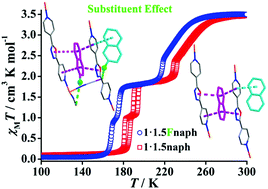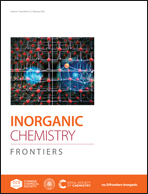The substituent guest effect on four-step spin-crossover behavior†
Abstract
Until now, the synthesis of new multi-step spin-crossover (SCO) materials is still a great challenge although they have attracted significant attention due to their potential applications in high-order data storage and multi-switches. Here, based on the four-step SCO complex [Fe(dpoda){Ag(CN)2}2]·1.5naph (1·1.5naph, dpoda = 2,5-di-(pyridyl)-1,3,4-oxadiazole, naph = naphthalene), the strategy of incorporating a substituent on an aromatic guest is applied. Since the replacement of H with an F atom can be regarded as isosteric substitution, the introduction of the 2-fluoronaphthalene (Fnaph) guest does not give rise to large structural changes and the four-step SCO behavior is maintained in 1·1.5Fnaph; however, fine-tuning of the framework is indeed achieved by the fluoro substituent. The spin transition temperatures of 1·1.5Fnaph shift to the low-temperature region, which should be due to the contributions of the size effect and the decrease in the Fe–N![[triple bond, length as m-dash]](https://www.rsc.org/images/entities/char_e002.gif) C angle. Meanwhile, the thermal hysteresis loop disappears, which results from the competitive contributions of the π⋯π and F⋯Ag interactions. Therefore, the F substituent on the guest can effectively modify the four-step SCO behavior, which provides a simple solution to synthesize more multi-step SCO materials.
C angle. Meanwhile, the thermal hysteresis loop disappears, which results from the competitive contributions of the π⋯π and F⋯Ag interactions. Therefore, the F substituent on the guest can effectively modify the four-step SCO behavior, which provides a simple solution to synthesize more multi-step SCO materials.



 Please wait while we load your content...
Please wait while we load your content...